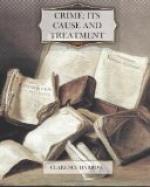Is there anything unreasonable in all of this? Is it outside of the other manifestations of life? Let us take disease. Clearly this is affected by heat and cold; beyond question it is largely the result of inherited susceptibilities. Poverty or wealth has much to do with disease. Many poor people die of tuberculosis, for instance, where the well-to-do would live. The span of life of the rich is greater than that of the poor. The long list of diseases from under-nourishment is mainly from the poor. Age affects disease, increasing the hazard of death. The food supply seriously affects health. Ignorance is a prolific cause of disease. Or, to speak more correctly, the lack of education and knowledge prevents men from living so that sickness will not overtake them, or so that they can recover when they are attacked by disease. The strength or weakness of the nervous system is a material factor.
The times of life, too, when the ravages of disease are greatest are as distinct as those of crime. And barring the fact that the few who are left at seventy rapidly drop away, the time of the greatest disasters would rather closely correspond with that of crime. Tuberculosis and insanity, for instance, take their greatest toll in the period of adolescence between fifteen and twenty-five years, just as crime does, and the percentage of both begins falling off rapidly after thirty.
Accidents can be as surely classified, and many of them in the same way. The poor naturally have more accidents than the rich; the ignorant more than the educated; the poorly-fed more than the well-nourished. Accidents are directly affected by climatic conditions; they are affected by human temperaments, by the strength and weakness of the nervous system, by the environment, by heredity, and by all the manifold stimuli that act on the human machine.
Legislatures have long since recognized that crime does not really stand as a separate and isolated phenomenon in human life. They have long since passed laws to safeguard the community against loss by accident and disease. A lengthening list of statutes can be found in our code regulating dangerous machinery, the operation of railroads, the running of automobiles, the construction of buildings, the isolation of the tubercular and those suffering from other contagious diseases, the amount of air-space for each person in tenement and work-shop, the use of fire-escapes and all of man’s conduct and activity for the prevention of accidents and disease.
Quite apart from the question of the wisdom or the foolishness of all this line of legislative activity, over which there will always be serious discussion, it is evident that criminal conduct even now occupies no unique or isolated place in law or human conduct. All unconsciously the world is coming to look on all sorts of conduct either as social or anti-social, and this regardless of what has already been classified as criminal. A few years since science was absorbed in the study of man’s racial origin and development. Today, biology and allied sciences are devoted to unraveling the complex causes responsible for individual development. It is fair to presume that this new effort of science may be able in time to solve the problem of crime, and that it may do for the conduct and mental aberrations of man what it has already done for his physical diseases.




